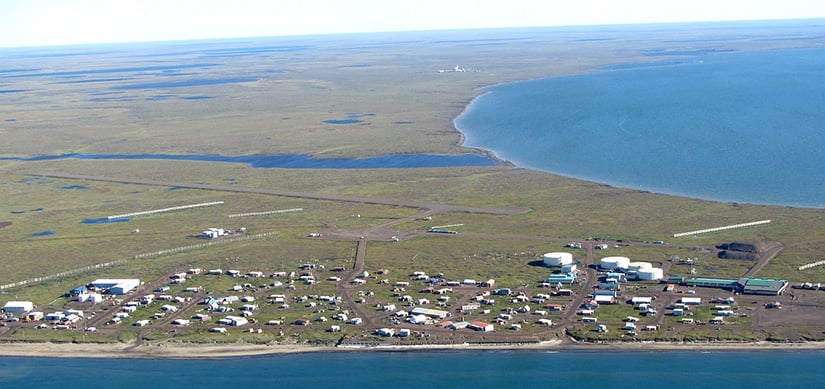Cohort 1: Wainwright, Alaska
Wainwright, Alaska, wanted to increase energy efficiency and thermal resilience for a municipal building through technical assistance from the Energy Technology Innovation Partnership Project (ETIPP).

An aerial view of Wainwright, Alaska. Photo from Palm, AK, Wikimedia Commons
Project Summary
 Population Size
Population Size
674
 Technology Focus
Technology Focus
Solar, battery energy storage system, electric thermal storage, energy efficiency
 Lead Lab
Lead Lab
National Laboratory of the Rockies
 Regional Partner
Regional Partner
Project Results and Publications
Energy Transitions Initiative Partnership Project: Wainwright, Alaska. Cohort 1 Technical Assistance: Assessment of Energy Efficiency, Renewable Energy, and Energy Storage Options, NLR Technical Report (2023)
ETIPP's partnership with Wainwright identified pathways to reduce operating costs, enhance indoor environmental quality, and improve the resilience of a 1,500-ft2 former federal armory building owned by the Tribe as it is renovated as a community multipurpose facility. The scope of work included evaluating multiple building efficiency measures, options for an on-site renewable energy system, and integrated energy storage system possibilities to help the building withstand grid outages and reduce diesel-fired energy use.
Project Outcomes
The ETIPP team worked with the community and its representatives to identify a mixture of energy efficiency measures, renewable energy systems, and energy storage systems that would drastically reduce annual operations and maintenance costs for a multi-use facility donated to the community while increasing the building’s thermal resilience.
Key Takeaways
Several challenges were associated with this project. The site of the multi-use facility had been unused and without power for more than 10 years, meaning no records of energy usage existed. Furthermore, the building had been moved twice, which stressed the major joints and necessitated some base repair and maintenance. The site and structure also needed additional civil engineering work because the building was 17 inches off-level and was situated in the primary drainage path for that portion of the village, requiring work to redirect water drainage.
Opportunities and Impacts
The ETIPP findings helped rule out some economically unworkable approaches, reinforced how much community champions matter to project success, and produced decision support that will enable the village of Wainwright to move forward when appropriate resources are fully in place. The project developer, Taġiuġmiullu Nunamiullu Housing Authority, continues to acquire funding to address the structural and civil engineering challenges so it can apply resources toward implementing reliable low-carbon energy systems.
Additional Information
Five Alaskan Entities Receive Technical Assistance From National Labs, Renewable Energy Alaska Project (2021)
New Federal Program To Help Five Remote Alaska Communities Transition to Renewable Energy, Alaska Public Media (2021)
Wainwright: Overlooking the Chukchi Sea, Arctic Slope Native Association
Wainwright, North Slope Borough
Share
Last Updated Dec. 7, 2025
